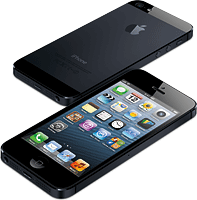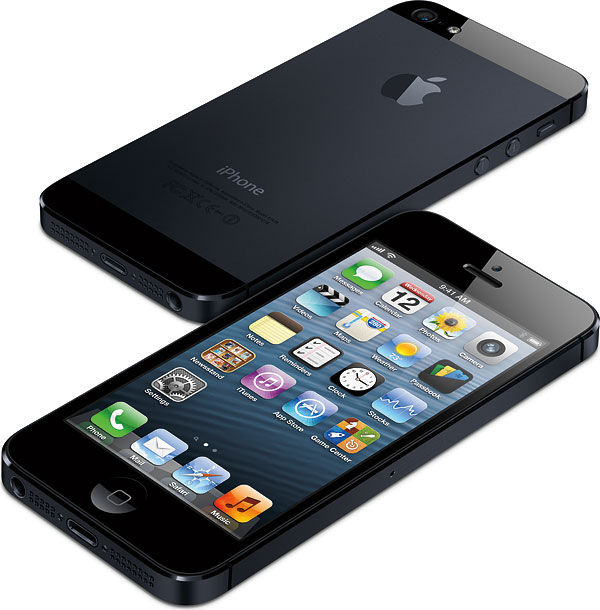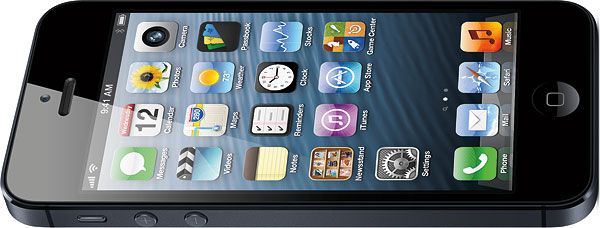Apple’s iPhone 5 camera promises better low-light performance, built-in panorama mode
posted Wednesday, September 12, 2012 at 3:10 PM EDT

For an hour or so, the world paused this afternoon as Apple fanatics--including many of us here at Imaging Resource--geeked out over the introduction of the iPhone 5. We've paid close attention to its upgrades, including those of its built-in iSight camera, and unfortunately it seems more evolutionary than revolutionary.
Most of the specs look very similar to those of the iPhone 4S, including an 8-megapixel, backside-illuminated sensor with hybrid infrared filter and an f/2.4 aperture, five-element lens. The overall camera module is said to be 25% smaller, though, and it isn't immediately clear if this is in comparison to that in the iPhone 4 or 4S. Hence we're not yet certain if it's a new optic, and if so whether the focal length has again changed. (The iPhone 4 had a focal length of 3.85mm, while the iPhone 4S lens had a focal length of 4.3mm.)
[Update: Apple has now posted a gallery of several full-resolution iPhone 5 photos. Presuming the attached EXIF information is correct, it would appear that the lens is new; it has a stated focal length of 4.1mm.]
One thing we do believe is new: the front of the lens is now protected with a sapphire glass element. That's a purer form of glass which is both stronger and more scratch resistant even than the much-hyped Corning Gorilla Glass, and other similar chemically-strengthened glass types. It's typically used for situations where scratch resistance is key, such as in the window over the barcode reader in supermarket checkout scanners. Its inclusion in the iPhone 5 means that you shouldn't have to worry about scratching the lens every time you set your phone down, or slip it in a pocket or bag.

Even if the camera hardware otherwise seems similar--or perhaps even the same--Apple notes that it has worked in some performance and creative improvements. The most interesting for iPhoneographers will be its improved low-light performance in what the company is calling Dynamic Low-Light mode. Apple's Senior VP of Worldwide Marketing, Philip W. Schiller, says that the iPhone 5 camera can use pixel binning techniques to combine data from adjacent pixels, trading off resolution against sensitivity and noise levels to give you two stops better low-light performance.
Also key is the addition of a native panorama function in the iPhone 5. Previous models relied on third-party software for panorama stitching, but Apple's latest and greatest can finally handle this by itself. Simply hold the phone vertically and sweep it across your scene; the rest is done automatically. This includes automatic removal of artifacts, duplicated people, and so on. There's no reduced-resolution requirement here, either: the iPhone 5 can output whopping 28 megapixel panoramas. (Of course, some of the third-party apps that preceded it offered high-res panorama stitching as well, so it's not really a new capability.)
Apple's decision to include high-res panorama stitching capability may in part come thanks to a newer, faster processor at the heart of the iPhone 5. Apple's A6 system-on-chip is said to offer roughly double the performance of the A5 processor, both for graphics and regular usage. (The company highlighted the performance improvements for a variety of specific tasks, of which one stands out for photographers. Saving a photo from the iPhoto app is apparently about 1.7 times faster.)

As well as the performance improvement, the new A6 SoC is now said to include an image signal processor that--among other things--performs spatial noise reduction, suggesting Apple may have made a step forwards in this area.
Like the iPhone 4S before it, the iPhone 5 also allows Full HD (1,920 x 1,080 pixel) video capture, and includes digital image stabilization. It's still performed entirely in software, rather than mechanically, but Apple did claim that improvements had been made in the stabilization performance. You can also now shoot still images during video capture, something we've seen in certain standalone cameras and other smartphones such as the HTC One X.
Another important difference is the larger four-inch, 16:9 aspect screen with 44% greater saturation, which still has 326 dpi resolution. (Apps not optimized for the wider aspect will show black bars, rather than rescaling or stretching.) The screen now has built-in touch sensors for reduced glare, and is said to be 30% thinner. That no doubt contributes much of the 18% savings in the phone's overall thickness; weight has dropped by 20% in the process.

While the updates for the rear iSight camera are relatively modest, the front-facing FaceTime camera has finally received a long-overdue update. Previously VGA only, this now offers 720p (1,280 x 720 pixel) high definition capture, and has switched to a backside-illuminated sensor for better image quality.
Apple has also updated the iPhone 5's audio capture capabilities, adding a third microphone into the mix. There are now mics on the front, bottom, and back of the phone.
Of course, these are just the changes that will be of most interest to photographers. Other differences include a new, smaller dock connector called Lightning (an adapter will be offered), an updated iOS 6 operating system (said to include over 200 new features), support for more natural-sounding wideband audio on calls (if supported by your carrier), better network connectivity (HDPA+, DC-HSPDA, and LTE), and better WiFi connectivity (adds 802.11a and 5GHz 802.11n support).

Battery life is said to be around eight hours of 3G talktime or browsing, eight hours of LTE browsing, ten hours of WiFi browsing or video playback, and 40 hours of music playback. Standby time is stated as 225 hours.
The Apple iPhone 5 will be available from 240 carriers in 100 countries by the end of 2012. Pre-orders start from September 14 in the US market, where pricing with a two-year contract is US$200 for a 16GB model, US$300 for a 32GB variant, and US$400 for a 64GB phone. Two colors will be offered: either white with silver trim, or black with slate trim. The iPhone 4 and 4S will continue to be offered in the US market, with the 4S priced at US$99 with a two-year contract, and the iPhone 4 offered free with contract.